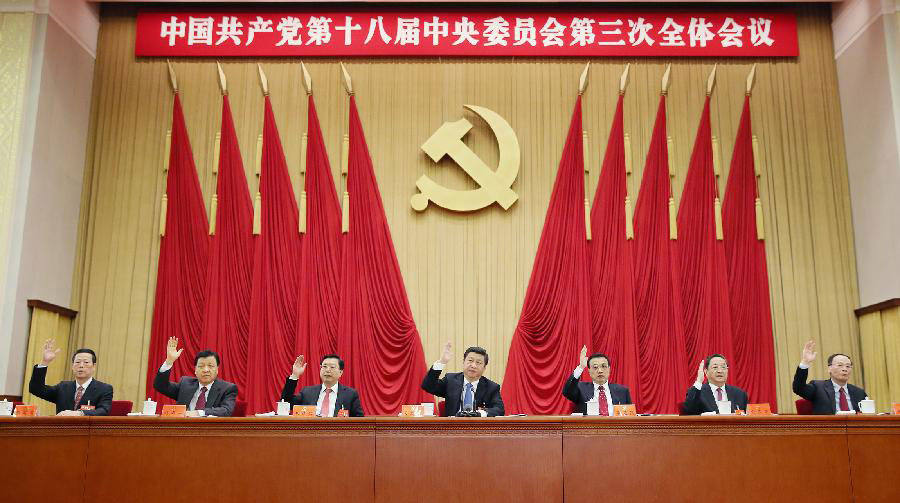By Jeff Ferry, CPA Research Director
The Trump administration’s rumored Section 301 investigation of Chinese trade practices opens up a new front in the ongoing “trade wars” with China, this time over intellectual property. A key event driving concern over Chinese use or abuse of foreign intellectual property was China’s publication of an ambitious industrial plan, known as Made in China 2025. That report has aroused anxiety among US tech executives and government officials. It sets out aggressive goals for Chinese growth in key sectors of the technology and advanced manufacturing industries, and specifies high levels of domestic (i.e. Chinese-produced) content. According to one Washington insider, the German government is so worried about Made in China 2025 that one German official has said that if the plan succeeds in reaching its goals it would mean the demise of German industry as we know it today.
Made in China 2025 (MIC 2025) is an effort by the Chinese leadership to address China’s reputation as a manufacturer of low-quality mass produced goods by remaking China’s industrial sector into a global leader in high technology products and advanced manufacturing techniques. Published in 2015, the plan identifies ten key sectors (see Figure 1), which include what most people think of as high tech (information technology), as well as four key transportation sectors (aerospace, maritime, rail, and energy-saving vehicles), advanced manufacturing technologies (robotics), and finally new technologies (new materials, biomedicine) where the applications are not known yet but likely to be broad and powerful. Note that many of these industrial sectors are directly relevant to military and security capabilities, both in the physical sense (ships and planes) and in the cyber sense (IT and cloud).
According to one estimate, the sectors targeted in MIC 2025 account for some 40% of China’s industrial production. But apart from its breadth, the most striking feature of the report is its emphasis on domestic production and domestic content. MIC 2025 envisages the targeted industries growing via three phases: (1) localize and indigenize (2) substitute and (3) capture global market share. Under the first item, MIC 2025 emphasizes the importance of developing indigenous technology and locally-owned brands. The phrase “indigenous innovation” is used repeatedly in MIC 2025 and in the related “Green Paper” technical report that spells out the plan in greater detail. Substitution refers to the strategic goal of substituting domestic production for foreign imports as soon as Chinese companies have the capability to do so. Finally, once Chinese companies have the capabilities, their mission will be to go out and take market share around the world.
The Chinese government has set out very clear, aggressive targets for domestic market share in many sectors and sub-sectors. Many are targeted for 70% or 80% domestic market share by 2025. For example, the plan calls for 80% domestic share in new energy vehicles and high-tech ship components. In mobile phone chips, where China’s market share today is close to zero, the target for 2025 is 40%–a goal that poses a severe threat to the chipmaking industries of Taiwan and South Korea. Germany is worried about the 80% target for computer-controlled machine tools and manufacturing equipment and the 70% target for industrial robots. US executives are worried (or should be) about the 50% target for industrial software, the 60% target for cloud and big data software, and the 60% target for IT for smart manufacturing.
Note that if a US government official had announced a 70% domestic market share target in even a single significant industry as a goal for US policy, he or she would have been denounced worldwide for violating the shibboleths of free trade. Yet, less than two years after publishing MIC 2025, China’s President Xi journeyed to the Davos World Economic Forum in the Swiss Alps, made grand statements in favor of free trade, and was applauded by the assembled crowd of CEOs, political leaders, and journalists. It was a situation best summarized by the old Groucho Marx joke: “What would you rather believe? What I’m telling you or what you see with your own eyes?” Even as Xi spoke, Chinese industrialists were working hard to implement the policies to build domestic production, indigenous innovation, and acquisition of foreign IP. Yet the world’s fat cats and pontificators are simply unable to recognize the reality before them.
Only in Germany have we seen thinkers grappling seriously with China’s goal of becoming the world’s leading industrial power, and what it means for the rest of us. A 2016 report by Berlin’s Mercator Institute spelled out the details of MIC 2025 and commented (pg. 8): “in the long term China wants to obtain control over the most profitable segments of the global supply chains and production networks. If successful, Made in China 2025 could accelerate the erosion of industrial countries’ technological leadership across industrial sectors.”
What can the US do about China’s industrial master-plan? At the highest level, China’s plans threaten to destabilize the most valuable industries of the US, Japan, and our allies in the EU and elsewhere. China may not succeed in all aspects of its ambitious plan. But it is likely to succeed in some sectors. The US cannot afford, economically or militarily, to end up dependent on China for key product segments like semiconductors or maritime ship components. A Section 301 investigation followed by tariffs to stop US companies selling their IP for a pittance is a good idea, as is blocking Chinese acquisitions of US technology companies. But these are small steps. The US and its allies need to work together to tell China that if it chooses to build its own economy as a self-sufficient “indigenous” bloc, other nations will respond by doing the same, as a bloc. It is China, not the US, that is taking apart the world trade system, sector by sector.
For the skeptical reader who still believes that the US has some pre-ordained right to be the world’s leading economic superpower forevermore, let me close with four relevant data points:
- Smartphones. In the current quarter of this year, Chinese manufacturer Huawei is expected to surpass Apple and become the world’s number two maker of smartphones. Already in Q2, Huawei sold 38.5 million units, just behind Apple’s 41 million units. This quarter, Huawei will surpass Apple, helped by its more than 20% growth in the Chinese market. Apple saw a decline of an estimated 7% in its China sales in Q2, although some analysts say its sales in China are in “freefall.” The Chinese government has a strong interest in favoring China’s four smartphone manufacturers over Apple as a way of building the entire Chinese tech supply chain.
- Commercial Aviation. In May of this year, China’s first wide-body commercial jet, the C919, took its maiden flight. The jet’s maker, COMAC, will now join the multibillion dollar aerospace market that has been a Boeing-Airbus duopoly. COMAC already claims 570 orders for the new plane. Boeing and COMAC have a joint venture to do “finishing” to Boeing 737s in China. Boeing also has joint ventures with AVIC, Shanghai Airport Authority, and other Chinese companies.
- Supercomputers. This year, for the first time in more than 20 years, the US did not have one of the top three fastest supercomputers in the world. According to a respected tech industry ranking, Chinese research centers held positions one and two, with supercomputers rated at 93 and 33.9 petaflops respectively. Titan, a US machine at the Oak Ridge National Laboratory came in fourth, with a speed of 17.6 petaflops.
- Smart Manufacturing Research. In 2011, China surpassed the US in patent applications related to smart manufacturing technologies. That’s according to the Mercator Institute report, which commented (pg 40), “Chinese innovation activities are particularly strong in high technology fields with high political support: traditional industrial robots, wireless sensor networks, and smart sensors.”












